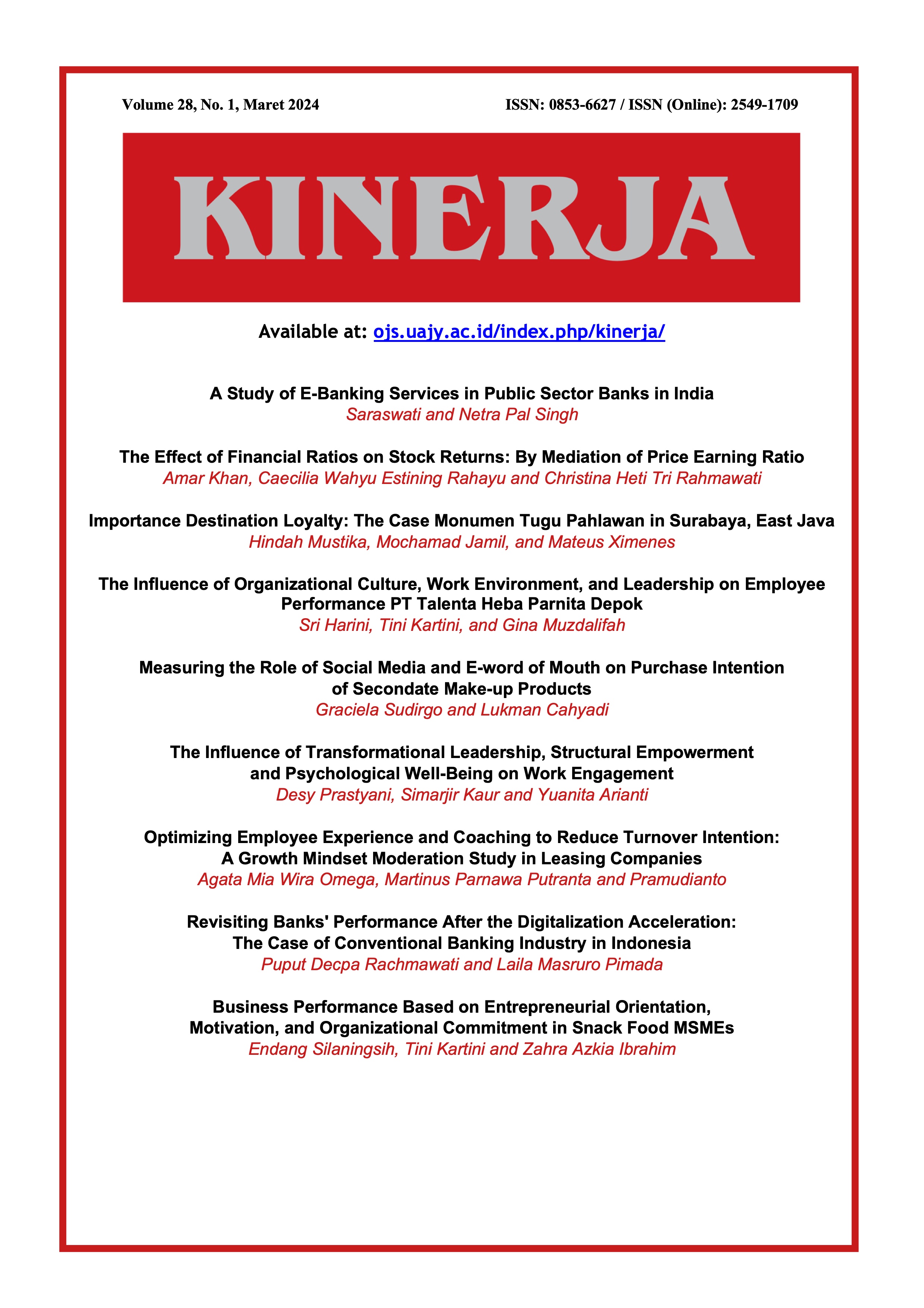Measuring the Role of Social Media and E-word of Mouth on Purchase Intention of Secondate Make-up Products
DOI:
https://doi.org/10.24002/kinerja.v28i1.8338Keywords:
parasocial interaction, social value, personal value, purchase intention, ewomAbstract
Purchase intention is important to pay attention to because it relates to consumer interest in trying, buying, and owning products such as beauty products. Furthermore, it can be seen from the consumer's behavior of parasocial interaction, social value, and personal value towards the influencer, which will affect their interest in buying the product. This research takes the object of research as an owner as well as an influencer for beauty products Secondate. The research design uses a deductive approach with a quantitative research model to determine the impact of influencers on the quality of parasocial interaction, social values, personal values, and e-wom on purchase intention. The sample of this study were secondary make-up users with a total of 169 respondents. Data analysis used the Structural Equation Model (SEM) method. The results of the study show that parasocial interaction affects social value. Parasocial interaction increases positive perceptions of personal value, and social value can increase consumer purchase intention, but personal value cannot attract consumer purchase intention. Parasocial interaction does not affect consumer purchase intention, so e-wom does not moderate the effect of parasocial interaction on consumer purchase intention. The results of this study concluded that social media can be a means to affect the interest in buying a product. With the respondent's research on social value and personal value, it can be said that it affects a person's buying interest in a product. Social value and personal value can help us to sort out which products we need and which are suitable for us.
References
Berne-Manero, C., Marzo-Navarro, M., 2020. Exploring how influencer and relationship marketing serve corporate sustainability. Sustainability, 12, 4392.
Carolina, C., Ruswanti, E., Pamungkas, R.A., 2021. Analysis on value perception, word of mouth, price, and trust towards patient loyalty at Proklamasi Hospital, Jakarta. Journal of Multidisciplinary Academic, 5, pp.143–147.
Conroy-Beam, D., Goetz, C.D., Buss, D.M., 2015. Why do humans form long-term mateships? An evolutionary game-theoretic model. Advances in Experimental Social Psychology, 51, pp.1–39.
Ellison, B.T., Padgett, B.C. and Fowler, D.C., 2017, January. Social media celebrity endorsements effect on generation z's purchase intentions. In International Textile and Apparel Association Annual Conference Proceedings (Vol. 74, No. 1). Iowa State University Digital Press.
Hair, J.F., Hult, G.T.M., Ringle, C.M., Sarstedt, M., 2017. A Primer on Partial Least Squares Structural Equation Modeling (PLS-SEM). Thousand Oaks: Sage.
Hair Jr, J.F., Sarstedt, M., Hopkins, L., Kuppelwieser, V.G., 2014. Partial least squares structural equation modeling (PLS-SEM): An emerging tool in business research. European Business Review, 26, pp.106–121.
Hudson, S., Roth, M. S., Madden, T. J., and Hudson, R., 2015. The effects of social media on emotions, brand relationship quality, and word of mouth: An empirical study of music festival attendees. Tourism Management, 47, 68–76.
Jansom, A., Pongsakornrungsilp, S., 2021. How Instagram influencers affect the value perception of Thai millennial followers and purchasing intention of luxury fashion for sustainable marketing. Sustainability, 13, p.8572.
Jen, W., Tu, R., Lu, T., 2011. Managing passenger behavioral intention: an integrated framework for service quality, satisfaction, perceived value, and switching barriers. Transportation, 38, pp.321–342.
Khandual, A., Pradhan, S., 2019. Fashion brands and consumers approach towards sustainable fashion. Fast Fashion, Fashion Brands nd Sustainable Consumption, pp.37–54.
Kim, A. J., Ko, E., 2012. Do social media marketing activities enhance customer equity? An empirical study of luxury fashion brand. Journal of Business Research, 65, pp.1480–1486.
Kudeshia, C., Kumar, A., 2017. Social eWOM: does it affect the brand attitude and purchase intention of brands? Management Research Review, 40, pp.310–330.
Lee, J.E., Watkins, B., 2016. YouTube vloggers’ influence on consumer luxury brand perceptions and intentions. Journal of Business Research, 69, pp.5753–5760.
Lejoyeux, M., Weinstein, A., 2010. Compulsive buying. The American Journal of Drug and Alcohol Abuse, 36, pp.248–253.
Lim, X.J., Radzol, A.M., Cheah, J. and Wong, M.W., 2017. The impact of social media influencers on purchase intention and the mediation effect of customer attitude. Asian Journal of Business Research, 7(2), pp.19-36.
Mafra, A.L., Varella, M.A.C., Defelipe, R.P., Anchieta, N.M., de Almeida, C.A.G., Valentova, J.V., 2020. Makeup usage in women as a tactic to attract mates and compete with rivals. Personality and Individual Differences, 163, p110042.
Oe, H., Sunpakit, P., Yamaoka, Y., Liang, Y., 2018. An exploratory study of Thai consumers’ perceptions of “conspicuousness”: a case of luxury handbags. Journal of Consumer Marketing, 35, pp.601–612.
Pangkey, F.M., Furkan, L.M., Herman, L.E., 2019. Pengaruh Artificial Intelligence dan Digital Marketing terhadap Minat Beli Konsumen. Jurnal Magister Manajemen Unram, 8, pp.21–25.
Pongsakornrungsilp, S., Schroeder, J.E., 2011. Understanding value co-creation in a co-consuming brand community. Marketing Theory, 11, pp.303–324.
Purnamaningsih, P., Rizkalla, N., 2020. El papel de la interacción parasocial en la intención de los consumidores de comprar productos de belleza. Revista CEA, 6, pp.13–27.
Puspitasari, P., Tresnati, R., Oktini, D.R., 2017. Pengaruh content marketing terhadap minat beli konsumen (survei pada konsumen Thirteenth Shoes Bandung). Prosiding Manajemen, pp.116–121.
Rod, M., Ashill, N.J., Shao, J., Carruthers, J., 2009. An examination of the relationship between service quality dimensions, overall internet banking service quality and customer satisfaction: A New Zealand study. Marketing Intelligence & Planning, 27, 103–126.
Rubin, R.B., McHugh, M.P., 1987. Development of parasocial interaction relationships. Journal of Broadcasting & Electronic Media, 31, pp.279–292.
Ruswanti, E., Eff, A., Kusumawati, M., 2020. Word of mouth, trust, satisfaction and effect of repurchase intention to Batavia Hospital in West Jakarta, Indonesia. Management Science Letters, 10, pp.265–270.
Sarstedt, M., Becker, J.-M., Ringle, C.M., Schwaiger, M., 2011a. Uncovering and treating unobserved heterogeneity with fimix-pls: which model selection criterion provides an appropriate number of segments? Schmalenbach Business Review, 63, pp.34–62.
Sarstedt, M., Henseler, J. and Ringle, C.M., 2011. Multigroup analysis in partial least squares (PLS) path modeling: Alternative methods and empirical results. Measurement and Research Methods in International Marketing, pp.195-218.
Silva, A., Lo, P.C. and Lim, E.P., 2021, May. On predicting personal values of social media users using community-specific language features and personal value correlation. In Proceedings of the International AAAI Conference on Web and Social Media (Vol. 15, pp. 680-690).
Sokolova, K., Kefi, H., 2020. Instagram and YouTube bloggers promote it, why should I buy? How credibility and parasocial interaction influence purchase intentions. Journal of Retailing and Consumer Services, 53, p.101742.
Tandayong, F.A., Palumian, Y., 2022. Peranan influencer dalam meningkatkan parasocial interaction dan purchase intention produk kosmetik lokal Scarlett. Jurnal Ilmiah Manajemen dan Bisnis (JIMBis), 1, pp.171–191.
Vinzi, V.E., Chin, W.W., Henseler, J. and Wang, H., 2010. Handbook of partial least squares (Vol. 201, No. 0). Berlin: Springer.
Wardhana, H.W., Wahab, Z., Shihab, M.S., Yuliani, Y., 2021. Pengaruh Electronic Word Of Mouth (E-Wom) dan celebrity endorsement terhadap minat beli konsumen: Studi pada e-commerce Zalora dengan brand image sebagai variabel mediasi. Coopetition: Jurnal Ilmiah Manajemen, 12, pp.431–446.
Yulianingsih, Syah Tantri Yanuar, R., Anindita, R., 2019. How packaging, product quality and promotion affect the purchase intention? Russian Journal of Agricultural and Socio-Economic Sciences, 92, pp.46–55.
Zhan, L., He, Y., 2012. Understanding luxury consumption in China: Consumer perceptions of best-known brands. Journal of Business Research, 65, pp.1452–1460.
Zhang, B., Kim, J.-H., 2013. Luxury fashion consumption in China: Factors affecting attitude and purchase intent. Journal of retailing and consumer services, 20, pp.68–79.
Zhang, K., Hung, K., 2020. The effect of natural celebrity–brand association and parasocial interaction in advertising endorsement for sustainable marketing. Sustainability, 12, p.6215.
Zheng, X., Men, J., Xiang, L. and Yang, F., 2020. Role of technology attraction and parasocial interaction in social shopping websites. International Journal of Information Management, 51, p.102043.
Downloads
Published
Issue
Section
License
Copyright (c) 2024 Graciela Sudirgo, Lukman Cahyadi

This work is licensed under a Creative Commons Attribution 4.0 International License.















